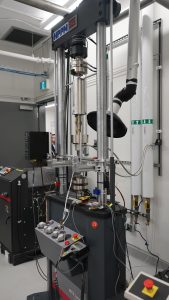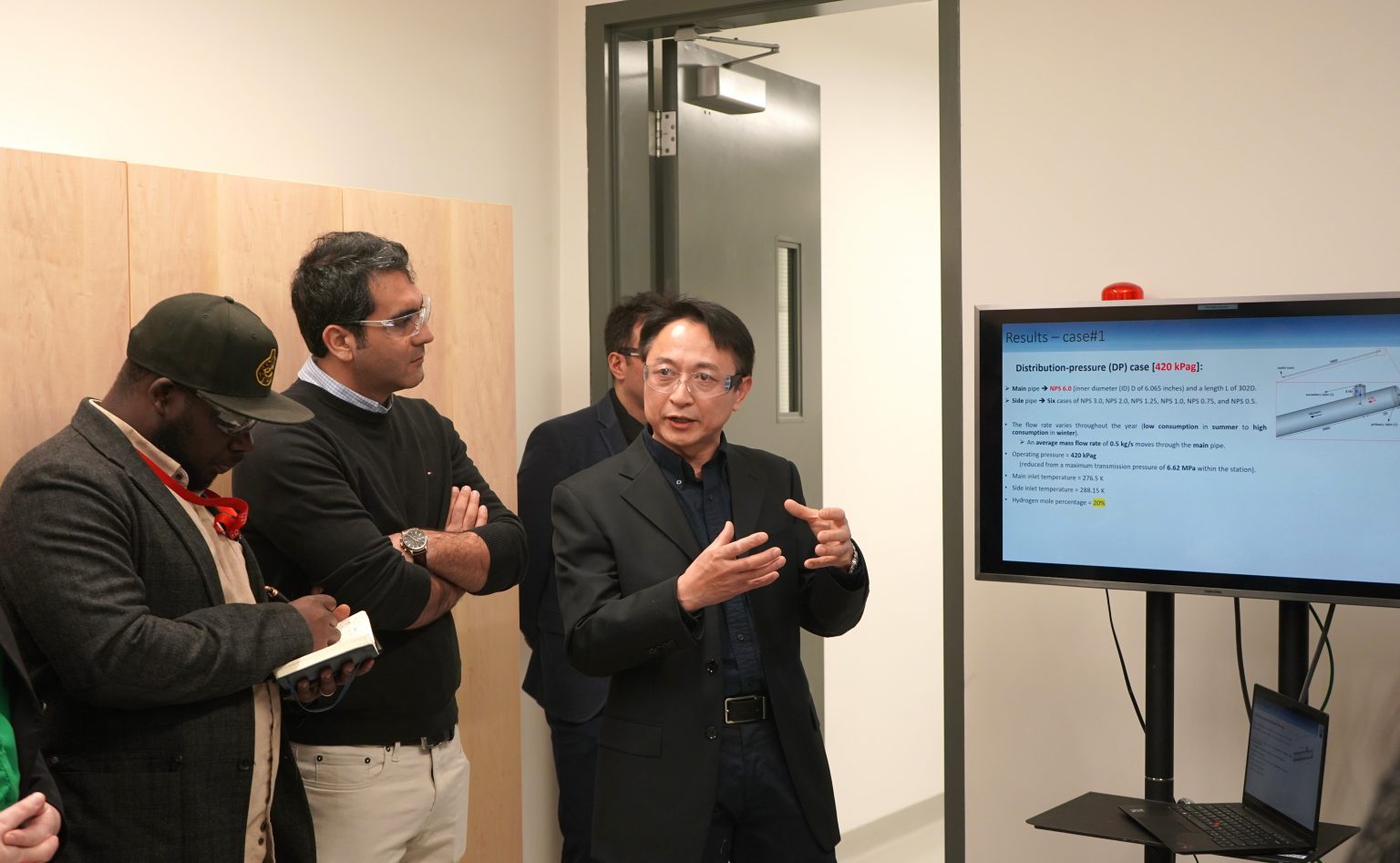
Dr. Joshua Brinkerhoff and Dr. Will Hughes of UBCO School of Engineering
Investment from FortisBC is propelling low-carbon innovation at UBCO
The University of British Columbia Okanagan (UBCO) recently powered up a new hydrogen research lab (H2LAB)—one of the most advanced of its kind in North America. FortisBC Energy Inc. (FortisBC) is supporting the project, helping the university drive innovation and hydrogen energy research. FortisBC hopes to understand how hydrogen can be blended into its gas supply, allowing this renewable and low-carbon gas[1] to play a role in meeting the energy needs of homes and businesses while supporting B.C.’s climate action plan.
The H2LAB located in UBCO’s Innovation Precinct is a cutting-edge space more than five years in the making. The 2,000 square foot lab was made possible by $2.3 million in funding by UBC, bolstered by $500,000 in research funding by FortisBC and another $800,000 from the Natural Sciences and Engineering Research Council of Canada.

Dr. Sina Kheirkhah presents his hydrogen research.
According to Dr. Will Hughes, Director of UBCO’s School of Engineering, the H2LAB is an investment that not only elevates UBCO’s research, educational opportunities for students and innovation capacity, but is a facility that can bring long-term positive impact for industry in the region, the province and beyond.

Equipment in the H2LAB.
“The H2Lab is a world-class space for clean energy innovation to occur right here in the Okanagan,” says Dr. Hughes. “That kind of innovation doesn’t happen in a vacuum—it takes collaboration. We are deeply grateful to FortisBC for their support of the research already going on in the lab. We view this lab as a hub for academia and industry to work together to advance low-carbon energy knowledge, testing, techniques and infrastructure.”
As a critical energy provider, FortisBC is leading the way in developing low-carbon[2] energy options like Renewable Natural Gas[3] (RNG), being the first utility in North America to offer a voluntary RNG program 15 years ago. FortisBC continues to invest in innovative solutions, such as hydrogen, to further reduce carbon emissions and advance climate action.
“Through innovation, FortisBC is taking steps to help reduce emissions while meeting the energy needs of homes and businesses across our province,” said Dawn Mehrer, vice president of corporate services and technology at FortisBC. “Our collaboration with UBCO and their research at the H2Lab is a key part of this journey. Together, we’re exploring how hydrogen can be integrated safely and effectively into our gas system, and the insights we’re gaining will play a vital role in shaping the future of low-carbon energy, including hydrogen blending with natural gas to reduce emissions even further.”
Today, UBCO and FortisBC representatives toured the lab for the first time since it was in operation. Research was also on display today from Dr. Dimitry Sediako’s colleagues Dr. Joshua Brinkerhoff, Dr. Sina Kheirkhah and Dr. Sunny Li who are all furthering hydrogen research and innovation with their teams at UBCO.

Dr. Sunny Li discusses computer modelling in hydrogen research.
One of the UBC engineering researchers already at work in the lab is Dr. Sediako, who also heads up UBCO’s High Performance Powertrain Materials lab.
Dr. Sediako and his team are currently exploring the effects of hydrogen and hydrogen-enriched natural gas on existing infrastructure.
“We are so lucky to have FortisBC with us as an industry partner as we work to advance hydrogen testing and technology at UBCO,” says Dr. Sediako. “Hydrogen gas has applications for so many industries and sectors, so being able to test materials and techniques is critically important as we work toward wider adoption.”
Dr. Sediako points out that while many people have heard of hydrogen being explored for usage in the energy sector and other industries there are still many misconceptions around its safety and deployment. Among other applications, this lab will work to study possible issues with the hope of one day having hydrogen safely and reliably delivered through existing gas infrastructure.

PhD student Rashiga Walallawita shares examples from his research on hydrogen embrittlement.
“Today is all about celebrating the collaboration between FortisBC and UBCO—where we are, and where we are going, with hydrogen research,” said Dr. Hughes. “We’re proud to showcase this space and let industry and community know that it stands at the ready. Come and work with us. Bring us your challenges and opportunities. Be part of hydrogen innovation in the region. Our doors are open.”
For more information on FortisBC and hydrogen, visit fortisbc.com/hydrogen.
For more information on UBCO, visit: ok.ubc.ca.
About UBC Okanagan / School of Engineering
UBC’s Okanagan campus is an innovative hub for research and learning founded in partnership with local Indigenous peoples, the Syilx Okanagan Nation, in whose traditional, ancestral and unceded territory the campus resides. The Okanagan campus combines a globally recognized UBC education with a tight-knit and entrepreneurial community that welcomes students and faculty from around the world in British Columbia’s stunning Okanagan Valley. The most established and influential global rankings all consistently place UBC in the top five per cent of universities in the world, and among the top three Canadian universities. The latest subject rankings from Times Higher Education, QS World University Rankings for engineering and technology, and Maclean’s place UBC Engineering second-highest in Canada, and 25th globally according to QS. For more visit ok.ubc.ca.
About FortisBC Energy Inc.
FortisBC Energy Inc. is a regulated utility focused on providing safe, reliable and affordable energy, including natural gas, Renewable Natural Gas and propane. FortisBC Energy Inc. employs around 2,143 British Columbians and serves approximately 1,086,500 customers across British Columbia. FortisBC Energy Inc. owns and operates two liquefied natural gas storage facilities and approximately 51,600 kilometres of gas transmission and distribution lines. FortisBC Energy Inc. is a subsidiary of Fortis Inc., a leader in the North American regulated electricity and gas utility industry. FortisBC Energy Inc. uses the FortisBC name and logo under license from Fortis Inc. For further information on FortisBC Energy Inc., visit fortisbc.com. For further information on Fortis Inc., visit fortisinc.com.
[1] FortisBC uses the term renewable and low-carbon gas to refer collectively to the low-carbon gases or fuels that the utility can acquire under the Greenhouse Gas Reduction (Clean Energy) Regulation, which are: Renewable Natural Gas (also called RNG or biomethane), hydrogen, synthesis gas (from wood waste) and lignin. FortisBC’s renewable and low-carbon gas portfolio currently includes only Renewable Natural Gas. Other gases and fuels may be added to the program over time. Depending on their source, all of these gases have differing levels of lifecycle carbon intensity. However, all of these gases are low carbon when compared to the lifecycle carbon intensity of conventional natural gas. The current burner tip emission factor of RNG is 0.27 grams of carbon dioxide equivalent per megajoule of energy (gCO2e/MJ) and the current renewable and low-carbon gas portfolio lifecycle emissions for stationary combustion are -22 gCO2e/MJ. This is below B.C.’s low carbon threshold for lifecycle carbon intensity of 30.8 gCO2e/MJ as set out in the 2024 Greenhouse Gas Reduction Regulation amendments.
[2] When compared to the lifecycle carbon intensity of conventional natural gas. The burner tip emission factor of FortisBC’s current Renewable Natural Gas (also called RNG or biomethane) portfolio is 0.27 grams of carbon dioxide equivalent per megajoule of energy (gCO2e/MJ). FortisBC’s current RNG portfolio lifecycle emissions for stationary combustion are -22 gCO2e/MJ. This is below B.C.’s low carbon threshold for lifecycle carbon intensity of 30.8 gCO2e/MJ as set out in the 2024 Greenhouse Gas Reduction Regulation amendments.
[3] Renewable Natural Gas (also called RNG or biomethane) is produced in a different manner than conventional natural gas. It is derived from biogas, which is produced from decomposing organic waste from landfills, agricultural waste and wastewater from treatment facilities. The biogas is captured and cleaned to create RNG. When RNG is added to North America’s natural gas system, it mixes with conventional natural gas. This means we’re unable to direct RNG to a specific customer. But the more RNG is added to the gas system, the less conventional natural gas is needed, thereby reducing the use of fossil fuels and overall greenhouse gas emissions.